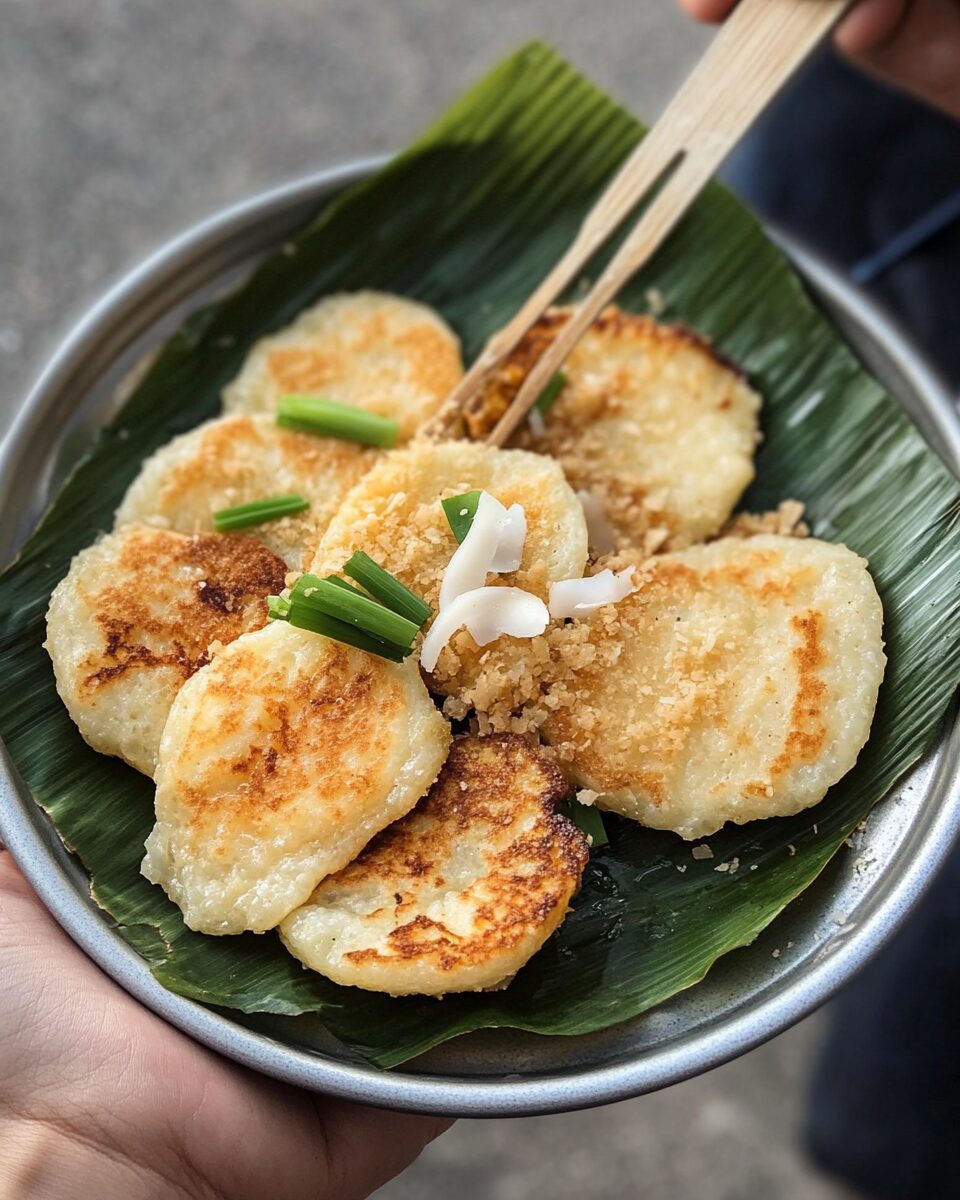These Thai Coconut Pancakes, known as Kanom Krok, are a cherished treat in Thailand’s vibrant street food scene. Each mini pancake is a delightful combination of creamy coconut custard and a lightly crisped rice flour base, often adorned with toppings like sweet corn, chopped scallions, or taro. The contrast of textures and rich tropical flavor makes them irresistibly delicious. Traditionally made on special cast-iron pans, Kanom Krok are easy to recreate at home with an aebleskiver or takoyaki pan. Whether you enjoy them sweet or with a hint of savory, this recipe brings authentic Thai flavor straight to your kitchen. Perfect for tea-time treats, party snacks, or a cozy dessert night!
Full Recipe:
Ingredients:
-
1 cup rice flour
-
1/2 cup cooked jasmine rice
-
1 1/2 cups coconut milk
-
1/4 cup sugar
-
1/4 tsp salt
-
1/2 cup shredded fresh coconut (optional)
-
2 tbsp rice flour (for the topping batter)
-
1/4 cup coconut cream (for the topping batter)
-
2 tbsp sugar (for the topping batter)
-
1/4 tsp salt (for the topping batter)
-
Chopped green onions, sweet corn, or taro (topping options)
-
Oil for greasing the pan
Directions:
-
In a blender, combine rice flour, cooked jasmine rice, coconut milk, sugar, and salt. Blend until smooth to form the base batter.
-
In a separate bowl, mix the topping batter ingredients: rice flour, coconut cream, sugar, and salt. Stir until smooth.
-
Heat a kanom krok pan (or aebleskiver pan) over medium heat and lightly grease each cavity with oil.
-
Pour the base batter halfway into each mold. Then, carefully spoon the topping batter over it.
-
Sprinkle your preferred toppings such as green onions, corn, or taro.
-
Cover the pan with a lid and cook for 4–6 minutes, or until the edges are golden and the centers are slightly firm but still jiggly.
-
Use a small spoon to gently lift the pancakes out of the molds. Serve warm.
Prep Time: 10 minutes | Cooking Time: 15 minutes | Total Time: 25 minutes
Kcal: 180 kcal | Servings: 4 servings
Exploring Kanom Krok: Thailand’s Irresistible Coconut Pancakes
When you stroll through a Thai street market, it’s hard to ignore the sweet, tropical aroma wafting from a small cast-iron pan sizzling over open flames. This is the birthplace of Kanom Krok, one of Thailand’s most beloved street snacks. Crisp on the outside, soft and creamy on the inside, and delicately sweetened with coconut, these miniature pancakes are a flavorful representation of Thai culinary artistry. This dish goes beyond a mere dessert it’s a cultural experience, a tradition passed down through generations, and a symbol of how simplicity in ingredients can yield spectacular results.
A Taste of Thai Street Food Culture
Thailand’s street food culture is a treasure trove of culinary delights, and Kanom Krok holds a special place in the lineup. Often made to order by skilled vendors working with lightning speed and precision, these little coconut gems are usually sold in sets of six or twelve, nestled in banana leaves or small paper trays. They’re most commonly found in morning markets or as part of an afternoon snack offering, particularly in more traditional neighborhoods.
What makes Thai street food like Kanom Krok so unique is the way it balances convenience with freshness. These pancakes are typically made right in front of the customer, hot off the pan, with ingredients prepped fresh that very morning. The sizzle of the batter hitting the hot pan, the aroma of toasted coconut milk, and the anticipation of that first creamy bite all contribute to an immersive sensory experience.
Historical and Cultural Roots
The origins of Kanom Krok date back centuries, although the exact period is debated. It is widely believed that this snack has roots in ancient Thai royal kitchens before making its way to street vendors and local markets. Historically, these small coconut cakes were reserved for special occasions and festivals, served during temple fairs or family gatherings as a symbol of hospitality and celebration.
One of the unique features of Thai desserts, and Kanom Krok in particular, is their reliance on natural ingredients such as coconut milk, rice flour, and palm sugar. These ingredients not only highlight the bounty of tropical Thailand but also reflect Buddhist values of simplicity and resourcefulness. In rural areas, families still prepare Kanom Krok using time-honored techniques and traditional cast-iron molds, often handed down from generation to generation.
The Allure of Texture and Flavor
What truly sets Kanom Krok apart from other desserts is its texture crisp on the edges but lusciously soft in the center. This contrast is achieved by using a two-part batter: the base batter provides the slightly chewy, rice-flour foundation, while the topping batter, rich with coconut cream, stays soft and custardy.
Flavor-wise, Kanom Krok hits a beautiful balance between sweet and slightly salty. The salt in the topping batter enhances the natural sweetness of the coconut and adds depth to every bite. For those unfamiliar with Southeast Asian desserts, this might be a revelation. Thai sweets often incorporate a mix of salty and sweet flavors, sometimes even adding savory elements like scallions or corn—ingredients that might seem unusual in Western dessert contexts but work harmoniously here.
Traditional Equipment: The Kanom Krok Pan
To achieve the iconic shape and texture of Kanom Krok, a special cast-iron pan is essential. Known locally as a kanom krok pan, it resembles an aebleskiver or takoyaki pan, with multiple shallow, semi-spherical molds. The pan is usually placed over charcoal or a gas flame and must be heated evenly before use.
Greasing the pan lightly ensures the pancakes lift out cleanly and develop a golden-brown crust. In many households, this pan is a prized possession, treated with care and sometimes passed down as a family heirloom.
For modern cooks without access to the traditional Thai pan, alternatives like an aebleskiver pan or a nonstick cake pop maker can offer similar results.
Variations and Toppings
While the traditional version of Kanom Krok is delicious on its own, it’s common to find variations across different regions of Thailand. Some popular topping combinations include:
-
Chopped green onions – for a slightly savory contrast
-
Sweet corn kernels – adding a pop of color and sweetness
-
Taro cubes – earthy and mildly sweet
-
Pumpkin bits – for a seasonal, creamy texture
-
Sesame seeds – adding nutty flavor and crunch
These toppings not only enhance the visual appeal but also play into the Thai culinary philosophy of balancing multiple textures and flavors in one bite. Some versions even incorporate pandan juice or butterfly pea flower extract for a vibrant green or purple hue, making the dish even more striking.
Dietary Notes and Allergen Information
One of the perks of Kanom Krok is its simplicity in ingredients, making it suitable for various dietary preferences. The base recipe is naturally:
-
Gluten-free – Made with rice flour, it’s safe for those with gluten sensitivities.
-
Vegetarian – No meat, dairy, or animal-based ingredients are involved.
-
Dairy-free and Vegan-friendly – Coconut milk and cream replace traditional dairy products.
For those watching sugar intake, you can modify the recipe to reduce sweetness without compromising texture. You can also explore sugar alternatives like monk fruit or stevia, although traditionalists may argue that it alters the authentic taste.
How to Serve and Enjoy
Kanom Krok is best enjoyed fresh off the pan while still warm, when the textures are at their peak. The creamy center sets slightly as it cools, but the crisp edges may soften over time. While some people eat them plain, others like to pair them with Thai tea or a refreshing iced coconut drink.
They also make a great party snack, especially when served in small tasting portions with a variety of toppings for guests to explore. Due to their bite-sized nature, they’re easy to pick up and eat with fingers no utensils needed, making them a perfect addition to buffet-style spreads or cultural food festivals.
Bringing Kanom Krok into the Modern Kitchen
The global rise in interest in Asian cuisine has made it easier than ever to recreate dishes like Kanom Krok at home. With the increasing availability of specialty cookware and authentic Thai ingredients online and in international grocery stores, home cooks can experiment with traditional recipes and even add their own creative flair.
If you’re hosting a themed dinner party or want to introduce your family to global flavors, Kanom Krok can be a show-stopping dessert. It sparks conversation, satisfies sweet cravings, and offers a glimpse into Thai culinary heritage.
Conclusion:
Thai Coconut Pancakes, or Kanom Krok, may be small in size, but they are mighty in flavor, tradition, and cultural resonance. Whether you’re enjoying them from a Bangkok street vendor or recreating them in your own kitchen, each bite is a celebration of Thai ingenuity and the magic of coconut.
More than just a dessert, Kanom Krok invites us to slow down and savor both the food and the traditions behind it. As international interest in global cuisines grows, this humble street snack stands tall as a flavorful ambassador of Thai culture. So the next time you’re craving something sweet, skip the usual and treat yourself to the rich, creamy wonder of Kanom Krok.

